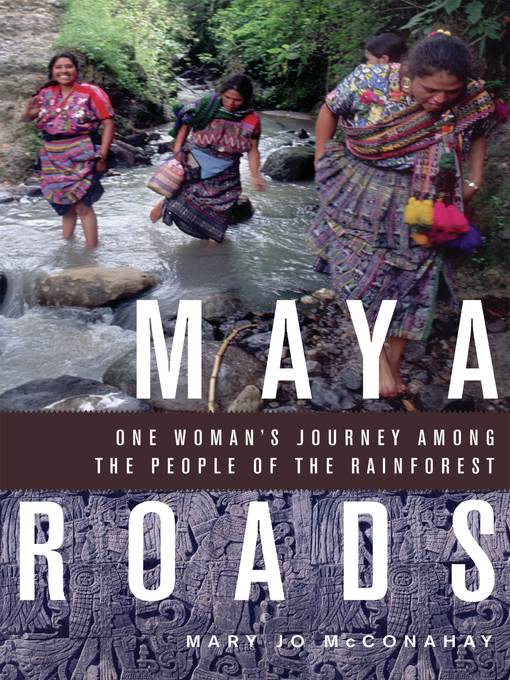
Maya Roads
One Woman's Journey Among the People of the Rainforest
فرمت کتاب
ebook
تاریخ انتشار
2011
نویسنده
Mary Jo McConahayناشر
Chicago Review Pressشابک
9781569769249
کتاب های مرتبط
- اطلاعات
- نقد و بررسی
- دیدگاه کاربران
نقد و بررسی

August 15, 2011
Equal parts travel narrative and meditation on Mayan cultural history, McConahay’s gripping memoir exposes the devastations of war. On a visit to Mexico City in 1973, McConahay saw an exhibit on the Lacandón Maya Indians that sparked an urge to find these last links to ancient Mayan culture. Over nearly four decades, she returned to Mayan sites in the vast rainforest spanning Mexico’s southern state of Chiapas and Guatemala’s northern state of Petén while working as a journalist. She records a personal odyssey along the clay roads running through the rainforest in which she participates in an archeological dig, an exhumation at the site of a massacre by government soldiers, and a Zapatista national convention; interviews Mayan priests, missionaries, and survivors of civil war; visits caves, standing stones, and burial mounds; and illuminates surprising holdouts (indigenous women, adorned with dead birds, who speak the Lacandón language). McConahay expresses her reverence for the rainforest with graceful imagery, describing, for example, the act of creation while listening to the sounds inside a waterfall. As the end of the fourth Maya era, on December 21, 2012, approaches, attention has focused on Mayan prophesies of apocalypse. McConahay’s insightful memoir suggests another story: Mayans’ veneration of nature, respect for human dignity, and expansive view of time are powerful antidotes to the poverty, drug-trafficking, violence, kidnappings, and destruction that has plagued rainforest settlements for decades.

June 1, 2011
A travel memoir of journeys in the jungles of Central America and encounters with the Lacandón people, descendants of the ancient Mayans.
Journalist McConahay has covered the Middle East and Central America for a variety of publications, but her fascination with Mayan culture predates her career. It began in 1973, when she visited the National Museum of Anthropology during a vacation in Mexico City. As an adult, she traveled 700 miles south to San Cristóbal, joining a fellow tourist and a guide to visit a Lacandón village at the border of the jungle. The inhabitants spoke a Mayan language, and while they had some acquaintance with Spanish culture, their way of life was traditional. Fish and beans were a mainstay of their diet, and the men used bows and arrows to hunt. Women pulled their long hair back into knots from which dead birds hung as ornaments. On her return trips, McConahay journeyed further into the jungle, looking at ruins and meeting an archaeo-astronomer who explained the Lacandón's ancient calendar to her. The author ponders the decline of Mayan culture from its height 2,000 years ago, imagining a parallel between their destructive power struggles and wars today. She also chronicles the Guatemalan civil war, the current encroachment on the rain forests by peasant farmers looking for land, large tourist destinations and the $40 billion drug trade through the region. She writes that since her first trip, the tropical forest has changed more than it had "in the entire five hundred years since the European conquest."
A layered examination of a place and a people whose ancient culture is rapidly disappearing.
(COPYRIGHT (2011) KIRKUS REVIEWS/NIELSEN BUSINESS MEDIA, INC. ALL RIGHTS RESERVED.)

July 1, 2011
Set mostly in Guatemala's Pet'n Province and Mexico's State of Chiapas, these are a journalist's reflections on her travels, presented in discrete episodes dating from 1973. That is the year she initially gravitated to the region, drawn by powerful curiosity about the Maya, their former civilization and its living descendants. If transportation and hostelry move her narratives along, perceptive depths of observation slow their pace as she describes encounters with people and muses on her understanding of their lives. Indicative rather than emphatic in expression, McConahay melds commentary about Mayan history and ruins, detections of Mayan vestiges in contemporary customs, and naturalistic description of the tropical forest to conjure a mood that transports the reader into the region and the culture. Though the spell sometimes breaks when her stories become modernistic (as in accounts of an archaeological excavation, an exhumation of massacre victims, and a rebellion in Chiapas), the vivid vicarious sensation of being in Central America holds McConahay's excursions together. Amid allusions to recent history, McConahay well appeases interest in the Maya, past and present.(Reprinted with permission of Booklist, copyright 2011, American Library Association.)

























دیدگاه کاربران